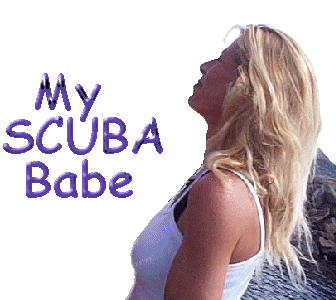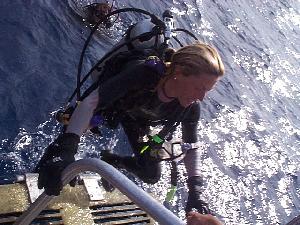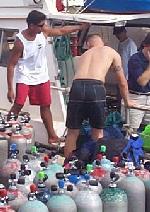
 Sunday, November 21, 1999, 80 feet down, off the leeward shore of Oahu, Hawaii -
Monique Korkowski is a Divemaster. She spends her days on the water and in the water, and her job is to guide humans into our marine world, take part in their adventure, and make sure they're still breathing when they float to the surface. Today, I am a minor challenge for her.
Sunday, November 21, 1999, 80 feet down, off the leeward shore of Oahu, Hawaii -
Monique Korkowski is a Divemaster. She spends her days on the water and in the water, and her job is to guide humans into our marine world, take part in their adventure, and make sure they're still breathing when they float to the surface. Today, I am a minor challenge for her.
We are on the dive site called "Black Rocks" out of Wainai, and I'm in a bit of trouble. We had been in an open cave at 80 feet, and I had enjoyed watching the fish, and watching my bubbles crash against the ceiling, but I was too uptight to play around, and too uptight to think straight, evidently. Today, as on most assignments, I'm trying to just keep with the flow and not cause any trouble. But I couldn't get my buoyancy right and I had been kicking like crazy. Korkowski had to come over to me, and with the slow mime language of divers, told me to "relax!" which I tried to do, but couldn't. When you're not familiar with the gear you're using, buoyancy can be a pain. This is why Korkowski, who has guided tours on this island for three years and is known around here as "The Scuba Babe" begins her job on the dock.
"My number one rule is to observe people first," she says. "I watch how they assemble their gear, I watch how they talk on the dock and on the boat. Are they excited? Are they nervous or unsure of themselves? People are an open book in this environment." By paying attention here, she can learn more about a person's diving abilities than she can from their C-card. She talks to them - not quizzing them, but feeling them out. For the next hour, she will have a dance with up to six partners and she will need to keep everyone in step. "There is a lot of psychology to this job," she says. My problem was my buoyancy, but not as a whole - my legs were too heavy and I just couldn't stay horizontal. I emptied my B.C. again and waited. My dive buddy, a student from California named Jeanine, was busy taking photographs, and I followed her around. As the buddy system goes, if I run low on air, we both run low, and I didn't want to cut Jeanine's dive short. I followed her out of the cave and tried to breathe more slowly. I have just glanced at Jeanine's air gauge and saw that it was straight up, at 2,300 lbs, and I only have 1,900. I decide to start using some common sense to do something about my situation. I realize that my weight belt is loose, and I tighten it, bringing it higher above my hips. This (duh) changes my balance and I level off. I am floating correctly now, and things get much easier. Korkowski comes by, checks my gauge and kicks off. To be a divemaster, you must have great confidence, and be able to maintain complete control over your situation. Divers are an independent bunch, and they pretty much do what they want, and each day, Korkowski jumps off a boat with complete strangers, who are divers in various stages of competence. She knows that they probably know what they're doing, but that many of them have at least one good reason to screw up, and no matter who they are, or how much they know, if they get into trouble, it's the Scuba Babe's butt on the line.
At 70 feet, we're taking in air pretty fast, and soon, our dive is nearly over. We slowly ascend, and Jeanine and I drift away from the group - she is chasing a few butterflies. I'm below 1,000 lbs and I want to encourage my buddy to start heading for the anchor line. She takes a few more snaps and I wait. I don't want to just leave her (especially since I may need to use her spare regulator.) I'm contemplating what to do, when My Scuba Babe comes to the rescue. Korkowski takes a look at my air gauge and then grabs my hand. Immediately, she spins around and swims hard for the ascent line with me in tow. We ascend to the 30-foot safety stop and she clamps my hand on the line. Korkowski takes her spare regulator and holds it in front of my face. I remove my regulator and use hers, forgetting, of course, to take a good breath first - not a good move, but I make the switch. Korkowski has two other divers with us, and she keeps an eye on her other charges. I use her tank for about half of my safety stop, and then I'm back on mine. We get to the surface and I climb back onto the boat. Korkowski is very protective of her divers. "I like to stay on top of them every minute," she says over the phone, weeks later. "I have eyeballs all over my head down there." In three years as a divemaster, her only malfunction occurred 100 feet down, when a diver's high-pressure hose developed a leak. "I had to bring him up from a hundred feet," she says. "I gave him to the captain, and went back down for the rest of my divers." Divemasters with the fewest heroic rescue stories are the ones who take the best precautions. "Because I am so careful with everything," she says, "the worst thing that's ever happened to me is to have someone go low on air. You weren't low, Mark, but you were getting low - you had less air than anybody else, and I wanted to be able to keep an eye on everyone." So, I was not in real trouble, but I might not have had enough air for a full safety stop. What Korkowski did was pre-empt a bad situation. I could have run low on air, I could have panicked, and I could have distracted her and other divers from protecting each other - her move was like hiding the liquor from the biker gang, rather then stopping the drunken brawl. Outdoor guides choose this career for love of the outdoors, but they soon find that the job is all about people, and with such inherent danger in diving, Korkowski's challenge begins on the boat. "My biggest problem is to get some people to pay attention to the briefing," she says. Before each dive, Korkowski addresses the group and tells them the profile (ours was: 80 feet for 17 minutes with a 3-minute safety stop at 30 feet.) the features (tunnel, wreck) hazards (current, sharks, wrecks) and hand signals. For some divers, this is like listening to a flight attendant explain seat belts. People who don't listen, do dangerous things, like entering an unstable wrecked ship or stupid things, like mooning passing tourist submarines.
Korkowski has dived for 24 years, and she loves being out on boats, she loves being in the water and she loves being with people. Though she has spent two decades in numerous jobs - everything from auto parts, to personal training, to walking Paris runways for Christian Dior - she considers diving to be her first "career" and this mother of three plans to make this her last career. The pay isn't great, but a divemaster usually can buy gear at cost, and they can earn a living doing what other people yearn to do. A week earlier, Korkowski led the cast from the broadway play "Miss Saigon" on a dive off the south shore.
At age 37, Korkowski has a job that would be great for someone in their twenties, but she keeps pushing and pushing, and she plans to keep at it "for the rest of my life." Dive guiding is a young person's vocation, and even though she says she feels younger and in better shape now than when she was 18, the pace will wear on her. So, she is taking classes to be an instructor. It has taken Monique Korkowski a long time to settle down and find a career for herself, but she has made a good choice, as scuba diving is something she loves and is very capable at. The "Scuba Babe" gets a thrill out of guiding humans through our marine world, and admits that the greatest motivation for her is one of the simplest, and it comes after most of her dives; "A smile at the surface is my biggest reward," she says.

Monique Korkowski finishes another dive, with a smile.
|
Return to our
MAIN page

 Captain Andrew supervises the loading of gear and dozens of tanks onto his boat, the South Seas II for today's dive.
Captain Andrew supervises the loading of gear and dozens of tanks onto his boat, the South Seas II for today's dive.


 Before our second dive, we have to wait for nitrogen to leave our blood, and we sit on our boat, the 38-foot South Seas II. We're moored 90 feet above the Mahi, a 186-foot mine sweeper that was sunk in 1982 to give tourists and fish something to play on. There is a fairly strong current, but I've had much worse, and the dive is easy. I have my weight belt on right and I float along as casually as the hundreds of millet-seed butterfly fish schooling near the hull.
Before our second dive, we have to wait for nitrogen to leave our blood, and we sit on our boat, the 38-foot South Seas II. We're moored 90 feet above the Mahi, a 186-foot mine sweeper that was sunk in 1982 to give tourists and fish something to play on. There is a fairly strong current, but I've had much worse, and the dive is easy. I have my weight belt on right and I float along as casually as the hundreds of millet-seed butterfly fish schooling near the hull.
 We had hoped to see turtles and sharks, for which Hawaiian waters are popular, but we don't - at least I don't. John Peeling pulls a huge crab to the deck, then throws him back. I do see the head of a large moray eel. These creatures hole up between rocks, with just their enormous heads poking out. They won't usually come out until they're bothered by antagonizing divers who wave their fingers at them, and then, in a flash, they jump out and bite that finger right off.
We had hoped to see turtles and sharks, for which Hawaiian waters are popular, but we don't - at least I don't. John Peeling pulls a huge crab to the deck, then throws him back. I do see the head of a large moray eel. These creatures hole up between rocks, with just their enormous heads poking out. They won't usually come out until they're bothered by antagonizing divers who wave their fingers at them, and then, in a flash, they jump out and bite that finger right off.
 Korkowski is an independent contractor for Aaron's dive shop, and others, and carries her own liability insurance. Aaron's is one of the oldest shops on Oahu, and has a good reputation here. In their Kaneohe store are photographs of celebrity divers, like Tom Selleck and Jerry Garcia - some of the thousands of people who have dived here. Aaron's also has worked with, and provides underwater communications gear for the production crew of "Baywatch"
Korkowski is an independent contractor for Aaron's dive shop, and others, and carries her own liability insurance. Aaron's is one of the oldest shops on Oahu, and has a good reputation here. In their Kaneohe store are photographs of celebrity divers, like Tom Selleck and Jerry Garcia - some of the thousands of people who have dived here. Aaron's also has worked with, and provides underwater communications gear for the production crew of "Baywatch"
 Korkowski is usually up at 4:30 each morning and will dive at least twice - weather permitting - sometimes four times, and without checking her log book, she figures she dives about 500 times a year. But, what does she do on her days off? "If I have any friends who want to go out, well, I'll go diving!" she says.
Korkowski is usually up at 4:30 each morning and will dive at least twice - weather permitting - sometimes four times, and without checking her log book, she figures she dives about 500 times a year. But, what does she do on her days off? "If I have any friends who want to go out, well, I'll go diving!" she says.
